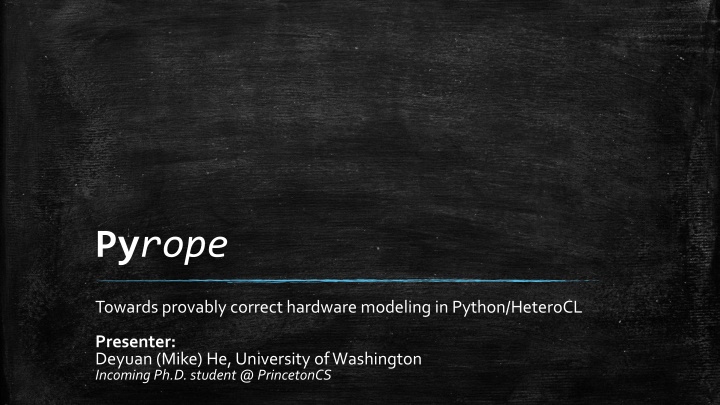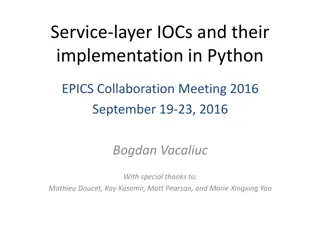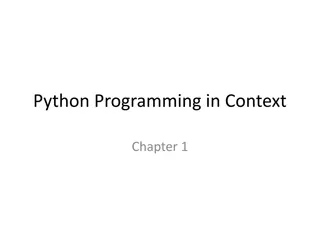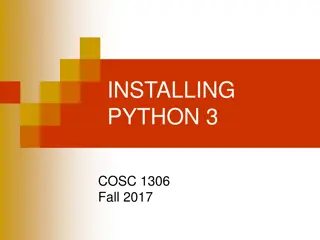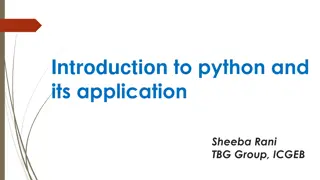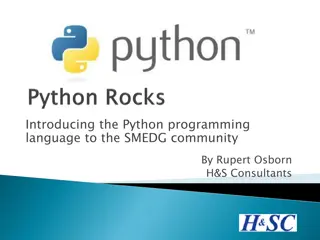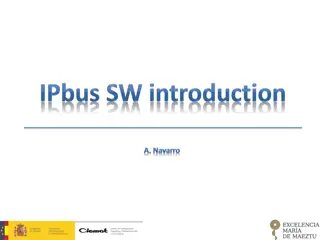Provably Correct Hardware Modeling in Python
Pyrope introduces a novel approach towards provably correct hardware modeling in Python using HeteroCL, explored by Deyuan (Mike) He, a Ph.D. student from the University of Washington. The rise of domain-specific languages like Halide is discussed, emphasizing the importance of abstraction levels with limited support for verification. HeteroCL decouples algorithms from hardware customizations, showcasing the formal verification challenges in computation correctness. Additionally, Dafny, a solver-aided language, is highlighted for automated verification leveraging Hoare Logic. The example of Heracles FHE Accelerator demonstrates the significance of encoding models with proofs and the convergence of high-level functional models. The goal of Pyrope is to bridge high-level modeling with verification for embedded DSLs.
Download Presentation

Please find below an Image/Link to download the presentation.
The content on the website is provided AS IS for your information and personal use only. It may not be sold, licensed, or shared on other websites without obtaining consent from the author.If you encounter any issues during the download, it is possible that the publisher has removed the file from their server.
You are allowed to download the files provided on this website for personal or commercial use, subject to the condition that they are used lawfully. All files are the property of their respective owners.
The content on the website is provided AS IS for your information and personal use only. It may not be sold, licensed, or shared on other websites without obtaining consent from the author.
E N D
Presentation Transcript
Pyrope Towards provably correct hardware modeling in Python/HeteroCL Presenter: Deyuan (Mike) He, University of Washington Incoming Ph.D. student @ PrincetonCS
The rise of Domain-specific languages Halide This Photo by Unknown Author is licensed under CC BY-NC This Photo by Unknown Author is licensed under CC BY 2
Why DSLs? All problems in computer science can be solved by another level of indirection. ---- David Wheeler import heterocl as hcl def kernel(x, weights, batch, func = hcl.compute(...) schedule = hcl.create_schedule(..., func) return hcl.build(schedule, target=...) for (int k = 0; k < K; ++k) { for (int i = 0; i < N; ++i) { for (int j = 0; j < M; ++j) { acc[i][j] += x[i][k] * y[j][k]; } } } in_feat, out_feat, dtype=hcl.Int()): 3
The rise of DSLs the missing part Halide Lift the level of abstraction; but have limited supports for verification 4
HeteroCL Decouples algorithms from hardware customizations Computation Codegen Schedule mov mov call insn ... %1 = load(...) %2 = load(...) %3 = compute(...) ... def matmul(x, y, n, m, k): return hcl.compute(...) Based on machine customizations (datatype, memory layout, etc.) How to formally verify the correctness of the computation? 5
Dafny A solver-aided language Developed by Microsoft Research: https://github.com/dafny-lang Automated verification using Hoare Logic: ensures the programs meet their specifications Preconditions Postconditions Specifications Verified Implementation Z3 SMT Solver Proof Failure message Reference: Zhenkun Yang, Wen Wang, Jeremy Casas, Pasquale Cocchini, Jin Yang. Towards A Correct-by-Construction FHE Model, 2022 6
Example: Heracles FHE Accelerator redc: ~10 LoC redc: ~250 LoC Work done by Zhenkun Yang manually encode models with proofs High-level functional model Easy to program with but not verified High-level functional model Require more expertise but verified Two parallel sources of truth 7
Design of Pyrope Goal: Embedded DSL; Bridge high-level modeling with verification Compile Proof. Testing without solver Run Q.E.D. 8
Pyrope Program Structure @module(...) @import_(...) @include(...) class MultiMontgomery(Module): @classmethod def ToNat(cls, xs: seq[UInt]) -> Nat: ... @function_method def LemmaSeqAppend(cls, xs: seq[UInt], x: UInt): ... @classmethod def FromNat(cls, n: Nat, l: Nat) -> seq[UInt]: ... @function_method @classmethod @lemma 9
Pyrope Frontend Language Module Decorators Method Decorators Proof Utilities @module() @import() @include() @lemma @function @method @function_method ensures/requires invariant() assert_by() 10
Pyrope Module Decorators Goals: Specify module dependencies (includes / imports) and compiled file Module compiling to @module('multimontgomery.dfy', abstract=True) @include('montgomery.dfy',) @import_(ExtendedGcd,) class MultiMontgomery(Module): ... External file to include Module to import Module definitions 11
Pyrope Module Decorators Goals: Specify module dependencies (includes / imports) and compiled file Parameterize the model Type placeholder T = TypeVar('T') @module('parameterized-example.dfy') @param(lambda args: (T, args[-1])) class ParameterizedExample(Module): def __init__(self, ty): super().__init__() Concretization Concrete type assigned @method def find_val(cls, xs: seq[T], val: T): 12
Pyrope Method Decorators lemma LemmaREDCDiv (T: nat, R: nat, N: nat, N_prime: nat) method REDC (R: nat, R_prime: nat, N: nat, N_prime: nat, T: nat) function method FromNat (n: nat, l: nat) : seq<uint> 13
Pyrope Method Decorators @lemma def LemmaREDCDiv(cls, T: Nat, R: Nat, N: Nat, N_prime: Nat) lemma LemmaREDCDiv (T: nat, R: nat, N: nat, N_prime: nat) 14
Pyrope Proof Utilities Goal: enabling Python to express proofs about programs Proof Specification assert_by( ) assert_expr( ) invariant( ) calc( ) Eq.by( ) Gt.by( ) Lt.by( ) Implies.by( ) ... requires( ) ensures( ) Forall( ) Exists( ) 15
Pyrope Proof Utilities Specification requires( ) ensures( ) Forall( ) Exists( ) Pre/postconditions Quantification over values / bounds 16
Pyrope Proof Utilities @method def find_max_in_positive_seq(cls, xs: seq[int]): requires(len(xs) > 0) requires(Forall(x > 0 for x in xs)) ensures(Forall(x <= ans for x in xs)) return ans 17
Pyrope Proof Utilities @method def find_max_in_positive_seq(cls, xs: seq[int]): requires(len(xs) > 0) requires(Forall(x > 0 for x in xs)) ans: int = xs[0] for i in range(1, len(xs)): if ans < xs[i]: ans = xs[i] ensures(Forall(x <= ans for x in xs)) return ans 18
Pyrope Proof Utilities Proof assert_by( ) assert_expr( ) invariant( ) calc( ) Eq.by( ) Gt.by( ) Lt.by( ) Implies.by( ) ... Proof certificates: providing evidence for the underlying solver 19
Pyrope Proof Utilities @method def find_max_in_positive_seq(cls, xs: seq[int]): requires(len(xs) > 0) requires(Forall(x > 0 for x in xs)) ans: int = xs[0] for i in range(1, len(xs)): invariant(1 <= i <= len(xs)) invariant(Forall(xs[j] <= ans for j in range(0, i))) if ans < xs[i]: ans = xs[i] ensures(Forall(x <= ans for x in xs)) return ans 20
Pyrope Verification via Dafny Extremely simple: @module('examples.dfy', abstract=False) class Examples(Module): @classmethod @method def find_max_in_positive_seq(cls, xs: seq[int]): instance = Examples() instance.verify() 21
Pyrope Verification via Dafny HOWEVER: this is not usually the case @method def find_max_in_positive_seq(cls, xs: seq[int]): requires(len(xs) > 0) requires(Forall(x > 0 for x in xs)) ans: int = xs[0] for i in range(1, len(xs)): invariant(1 <= i <= len(xs)) invariant(Forall(xs[j] <= ans for j in range(0, i))) if ans < xs[i]: ans = xs[i] ensures(Forall(x <= ans for x in xs)) return ans Unbounded! 23
Pyrope Other Features Assertions by proofs # m >= 0 and N >= 0 ==> m * N >= 0 assert_by(m * N >= 0, Mul.LemmaMulNonnegative(m, N)) 24
Pyrope Other Features Assertions by proofs Assertions by computations calc(Eq.by( (b + k * N) % N, # forall x, y :: x * y = y * x By.lemma(Mul.LemmaMulIsCommutativeAuto()), (N * k + b) % N, # forall x, m, N :: ((m * N) + x) % N = x % N By.lemma(DivMod.LemmaModMultiplesVanishAuto()), b % N)) = 25
Pyrope Other Features Parameterized models (can generate multiple verification targets) param_instance = ParameterizedExample(ty=Nat) param_instance.verify() param_instance = ParameterizedExample(ty=Bv32) param_instance.verify() 26
Pyrope Other Features Lemma importer (from Dafny proofs) from lemmas_lib.NonlinearArithmetic import DivMod from lemmas_lib.NonlinearArithmetic import Mul Preserve directory structure ... calc(Eq.by( (b + k * N) % N, By.lemma(Mul.LemmaMulIsCommutativeAuto()), (N * k + b) % N, By.lemma(DivMod.LemmaModMultiplesVanishAuto()), b % N)) ... 27
Case Study - Montgomery Reduction Algorithm Background: Goal: Given 2 natural numbers ?,? [0,?) for some ?, optimize the efficiency for computing ? ? % ?. 28
Case Study - Montgomery Reduction Algorithm @method def REDC(cls, R: Nat, R_prime: Nat, N: Nat, N_prime: Nat, T: Nat): m: Nat = T % R * N_prime % R t: Nat = (T + m * N) // R # range correction S: Nat = t - N if t >= N else t return S We want to verify ? % ? = ?? % ? where ? ? 1 (??? ?) Peter Montgomery. Modular Multiplication Without Trial Division 1985 29
Case Study - Montgomery Reduction Algorithm What need to be shown? @method def REDC(cls, R: Nat, R_prime: Nat, N: Nat, N_prime: Nat, T: Nat): m: Nat = T % R * N_prime % R t: Nat = (T + m * N) // R # range correction S: Nat = t - N if t >= N else t return S 1. T + m N is divisible by R 2. t < 2N 30
Case Study - Montgomery Reduction Algorithm What need to be shown? @method def REDC(cls, R: Nat, R_prime: Nat, N: Nat, N_prime: Nat, T: Nat): m: Nat = T % R * N_prime % R t: Nat = (T + m * N) / R # range correction S: Nat = t - N if t >= N else t return S ? % ? = ?? % ? Proof has been encoded in Pyrope and verified by compiling to Dafny 31
Handling HeteroCL Constructs Possible directions given current status of HeteroCL: HeteroCL is moving to MLIR: compiling from MLIR to Dafny is feasible Could refer to the schedule interpreter written by Dr. Steven Lyubomirsky Challenges: MLIR support is still WIP; may have many changes Error reporting will be tricky when dealing with verification failures 33
Whats next? Adding HeteroCL support Heracles FHE accelerator is modeled with HeteroCL Could help adding verification supports to MLIR Improve error reporting Easier to fix when verification failed Moving towards correct-by-construction modeling with a single source of truth Modeling in Python/HCL AND proving correctness with Pyrope 34
Recap 1. From general-purpose to domain-specific 2. Problems: verifying the correctness of the program in DSL 3. Pyrope: attempt to close the gap Take-away: It s a good practice to start proving while coding because 1. It helps understand the implementation better 2. It exposes issues of the proof infrastructure in early stage 3. It provides the highest confidence about the implementation correctness 35
Recap 1. From general-purpose to domain-specific 2. Problems: verifying the correctness of the program in DSL 3. Pyrope: attempt to close the gap Take-away: Easier to maintain when we have a single of source of truth because Specifications, proofs and implementations are closely coupled. 36
Acknowledgement I would thank all members in the DPRIVE team for supporting my work. I especially thank Zhenkun Yang and Jeremy Cases for their suggestions and help for improving Pyrope. I greatly appreciate Pasquale Cocchini for ideas on program verification for Python. I appreciate Jin Yang for providing the opportunity working with the DPRIVE project Finally, thank you all for your attention. 37
Q & A 38
Reference Zhenkun Yang, Wen Wang, Jeremy Casas, Pasquale Cocchini, Jin Yang. Towards A Correct-by-Construction FHE Model, 2022 Yi-Hsiang Lai, Yuze Chi, Yuwei Hu, Jie Wang, Cody Hao Yu, Yuan Zhou, Jason Cong, and Zhiru Zhang. 2019. HeteroCL: A Multi-Paradigm Programming Infrastructure for Software-Defined Reconfigurable Computing. In Proceedings of the 2019 ACM/SIGDA International Symposium on Field-Programmable Gate Arrays (FPGA 19), Association for Computing Machinery, Seaside, CA, USA, 242 251. DOI:https://doi.org/10.1145/3289602.3293910 Tianqi Chen, Thierry Moreau, Ziheng Jiang, Lianmin Zheng, Eddie Yan, Meghan Cowan, Haichen Shen, Leyuan Wang, Yuwei Hu, Luis Ceze, Carlos Guestrin, and Arvind Krishnamurthy. 2018. TVM: An Automated End-to-End Optimizing Compiler for Deep Learning. arXiv. DOI:https://doi.org/10.48550/ARXIV.1802.04799 Rustan Leino. 2010. Dafny: An Automatic Program Verifier for Functional Correctness. In 16th International Conference, LPAR-16, Dakar, Senegal, Springer Berlin Heidelberg, 348 370. Retrieved from https://www.microsoft.com/en- us/research/publication/dafny-automatic-program-verifier-functional-correctness-2/ Peter L. Montgomery. 1985. Modular Multiplication without Trial Division. Mathematics of Computation 44, 170 (1985), 519 521. 39
